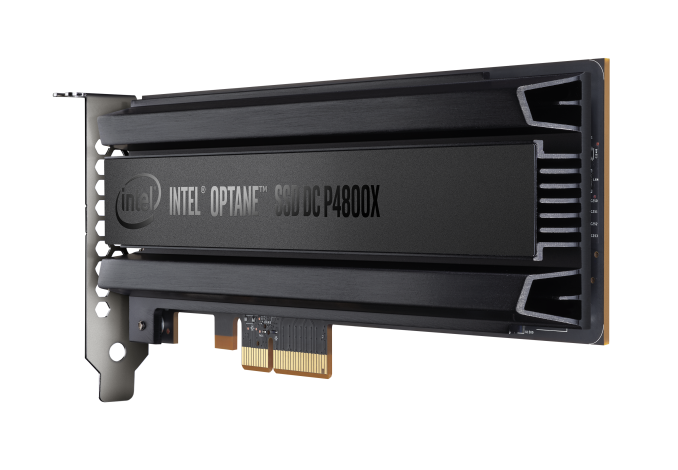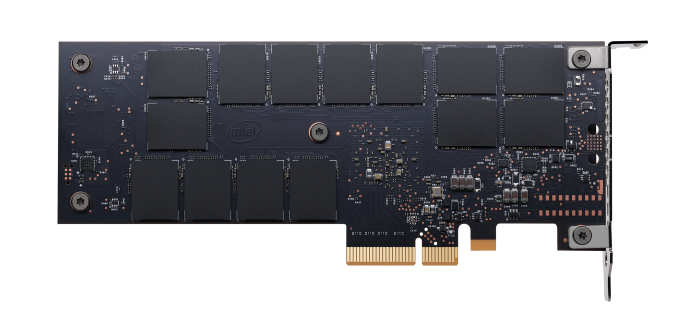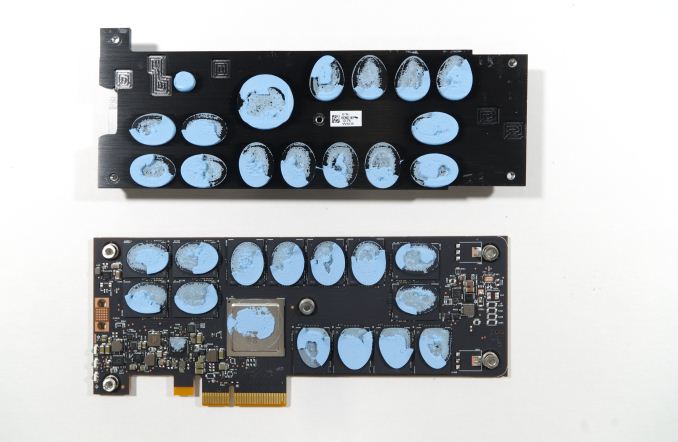Intel Optane SSD DC P4800X 750GB Hands-On Review
by Billy Tallis on November 9, 2017 12:00 PM EST
Intel's rollout of Optane products, based on 3D XPoint memory, continues. Today is the release of the 750GB Optane SSD DC P4800X, a larger capacity version of the model launched earlier this year. Now Intel's flagship enterprise SSD family has a more useful capacity while offering the same chart-topping performance as the 375GB model that launched earlier this spring.
We tested the 375GB model earlier this year through remote access to an Intel server lab. Last month, we reviewed the consumer counterpart to the P4800X, the Intel Optane SSD 900p. Today, we have the results of hands-on testing of the 750GB P4800X add-in card model.
The 750GB add-in card model was originally planned for a Q2 introduction, followed by the 750GB U.2 model and the 1.5TB models in the second half of 2017. Both 750GB models are now launching, and Intel says the 1.5TB models are "coming soon". This is a fairly minor delay, but that is of little comfort to customers who have been eagerly awaiting drives like this since 3D XPoint memory was first announced in July 2015.
| Intel Optane SSD DC P4800X Specifications | |||
| Capacity | 375 GB | 750 GB | |
| Form Factor | PCIe HHHL or 2.5" 15mm U.2 | ||
| Interface | PCIe 3.0 x4 NVMe | ||
| Controller | Intel SLL3D | ||
| Memory | 128Gb 20nm Intel 3D XPoint | ||
| Typical Latency (R/W) | <10µs | ||
| Random Read (4 kB) IOPS (QD16) | 550,000 | ||
| Random Read 99.999% Latency (QD1) | 60µs | ||
| Random Read 99.999% Latency (QD16) | 150µs | ||
| Random Write (4 kB) IOPS (QD16) | 500,000 | ||
| Random Write 99.999% Latency (QD1) | 100µs | ||
| Random Write 99.999% Latency (QD16) | 200µs | ||
| Mixed 70/30 (4kB) Random IOPS (QD16) | 500,000 | ||
| Sequential Read (64kB) | 2400 MB/s | ||
| Sequential Write (64kB) | 2000 MB/s | ||
| Active Power | Read | 8 W | 10 W |
| Write | 13 W | 15 W | |
| Idle Power | 5 W | 6 W | |
| Endurance | 30 DWPD | ||
| Warranty | 5 years | ||
| MSRP | $1520 | ||
The performance specifications of the Optane SSDs stand out in several ways.
The latency for reads at low queue depths is far lower than NAND flash-based SSDs. This can provide a boost to almost any application that waits on storage. With no complicated wear leveling and garbage collection process going on under the hood, the Optane SSDs offer much better performance consistency than most flash-based SSDs, to the point that Intel specifies 99.999th percentile latency for the Optane SSD.
Perhaps most significant is that capacity doesn't affect performance. For flash-based SSDs there is usually a very strong correlation between capacity and performance. The simpler, more direct architecture of Optane SSDs cuts out most of the intermediate buffering that flash SSDs need to perform well.
The sequential transfer speeds of the P4800X are not record-setting, and the read speed rating is actually 100MBps lower than that of the consumer Optane SSD 900p. However, nobody is going to buy an Optane SSD primarily for its sequential performance when flash-based SSDs can compete in that aspect at a fraction of the price. It is interesting to note that the sequential performance specifications are given for 64kB transfers, when 128kB is more common within the industry and 128kB transfers are supported by the Optane SSD.
Power consumption is the only area where the specifications differ between the 375GB and the 750GB model. The SSD DC P4800X does not implement the standard NVMe power state management or Autonomous Power State Transition features, but it does have a power governor setting controllable through vendor specific commands. This allows the P4800X to be limited to 12W instead of the default limit of 18W. Since imposing a lower power limit will reduce performance, this feature is probably not going to get much use with a product like the P4800X. There may be a few situations where it could be of use with the U.2 model that has less surface area for cooling, provided that it leads to more consistent performance than simply letting the drives thermally throttle.
The P4800X's write endurance rating of 30 drive writes per day is far higher than most enterprise SSDs and beats any previous Intel SSD, but it isn't actually high enough to put the Optane SSD in an entirely different class from the best high-endurance flash based SSDs. When the P4800X exhausts the rated write endurance, it will switch to a "write protect" mode where writes are throttled to 30MB/s. This is a gentler end of life strategy than the hard read-only mode that some of Intel's previous drives have used. The mode switch happens when the "Percentage Used Estimate" SMART indicator reaches 105%.
Once the P4800X has reached its write endurance rating, it is specified for unpowered data retention of 3 months, which is standard for enterprise SSD. Intel doesn't say anything directly about data retention when the drive is new, but the do caution that the drive will perform background data refreshing. When the drive is powered on, it will devote more time than usual to background data refreshing for a period of about three hours, to clean up any data degradation that may have occurred while the drive was off for an unknowable period of time.
| Model | Dies per channel | Channels | Raw Capacity | Spare Area | |||
| Intel Optane SSD 900p 280GB | 3 | 7 | 336 GB | 56 GB (16.6 %) | |||
| Intel Optane SSD DC P4800X 375GB | 4 | 7 | 448 GB | 73 GB (16.3 %) | |||
| Intel Optane SSD 900p 480GB | 5 | 7 | 560 GB | 80 GB (14.3 %) | |||
| Intel Optane SSD DC P4800X 750GB | 8 | 7 | 896 GB | 146 GB (16.3 %) | |||
The Optane SSD DC P4800X and the Optane SSD 900p both use the same 7-channel controller, which leads to some unusual drive capacities. The 900p comes with either 3 or 5 memory dies per channel while the P4800X has 4 or 8. All models reserve about 1/6th of the raw capacity for internal use.
Aside from the number of 3D XPoint memory packages and the number of dies they contain, the PCBs of the P4800X and the 900p differ only in the presence of a few diagnostic LEDs on the P4800X. Neither model has any large power loss protection capacitors because the Optane SSDs don't use any volatile caches and write immediately to the 3D XPoint memory itself.
The heatsinks and PCIe brackets are slightly different between the consumer and enterprise versions, but both are predominately black aluminum. The P4800X omits the solid backplate and instead places the label with model and serial numbers on the side of the heatsink.












58 Comments
View All Comments
"Bullwinkle J Moose" - Thursday, November 9, 2017 - link
Humor me.....How fast can you copy and paste a 100GB file from and to the same Optane SSD
I don't believe your mixed mode results adequately demonstrate the internal throughput
At least not until you demonstrate a direct comparison
Billy Tallis - Thursday, November 9, 2017 - link
Your concept of "internal throughput" has no basis in reality. File copies (on a filesystem that does not do copy-on-write) require the file data to be read from the SSD into system DRAM, then written back to the SSD. There are no "copy" commands in the NVMe command set."Bullwinkle J Moose" - Thursday, November 9, 2017 - link
"There are no "copy" commands in the NVMe command set."---------------------------------------------------------------------------------
That might be fixed with a few more onboard processors in the future but does not answer my question
How fast can you copy/paste 100GB on THAT specific drive?
"Bullwinkle J Moose" - Thursday, November 9, 2017 - link
Better yet, I'd like you to GUESS how fast it can copy and paste based on your mixed mode analysis and then go measure itLord of the Bored - Friday, November 10, 2017 - link
How will a new processor change that there is no way to tell the drive to do what you want? We don't trust storage devices to "do what I mean", because the cost of a mistake is too high. No device anyone should be using will say "it looks like they're writing back the data they just read in, I'mma ignore the input and duplicate it from the cache to save time." Especially since they can't know if the data is changed in advance.Barring a new interface standard, it will take exactly as long to copy a file to another location on the same drive as it will to read the file and then write the file, because that is the only provision within the NVMe command set.
"Bullwinkle J Moose" - Thursday, November 9, 2017 - link
What would happen if Intel Colludes with AMD to implement this technology into onboard graphics instead of AMD's plan to use Flash in their graphics cards ?Seems to me like Internal throughput would be very important to the design
Samus - Thursday, November 9, 2017 - link
That is also file system dependent. For example, in Mac OS High Sierra, you can copy and paste (duplicate) any size file instantly on any drive formatted with APFS.But your question of a block by block transfer of a file internally for a 100GB file would likely take 50 seconds if not factoring in file system efficiency.
cygnus1 - Thursday, November 9, 2017 - link
That's not a copy of the file though. It's just a duplicate file entry referencing the same blocks. That and things like snapshots are possible thanks to the copy on write nature of that file system. But, if any of those blocks were to become corrupted, both 'copies' of the file are corrupt."Bullwinkle J Moose" - Thursday, November 9, 2017 - link
Good call SamusI noticed that the Windows Fall Crappier Edition takes MUCH longer to copy/move/paste in several tests than the earlier versions of "Spyware Platform 10"
as well as gives me a "Format Disk Now?" Prompt after formatting a new disk with Disk Manager
as well as making a zero byte backup with Acronis 2015 (Possible anomaly, Will test again)
as well as breaking compatibility with several programs that worked in earlier versions
as well as asking permission to do anything with my files and then often failing to do it
as well as, well.....you get the idea, they fix one thing and break 5 more
Disclaimer:
I do NOT believe that xpoint could be used in its current form for onboard graphics!
But I'd like to know that the numbers you are getting at AnandTech match your/my expectations and if not, why not?
Sorry if I'm sounding like an AHole but I'd like to know what this drive can really do, and then what Microsoft graciously allows it to do ?
make sense?
PeachNCream - Friday, November 10, 2017 - link
It doesn't make sense to even care what a client OS would do with this drive. It's enterprise hardware and is priced/positioned accordingly. Instead of the P4800X, check out the consumer 900p version of Octane instead. It's a lot more likely that model will end up sitting in a consumer PC or an office workstation.